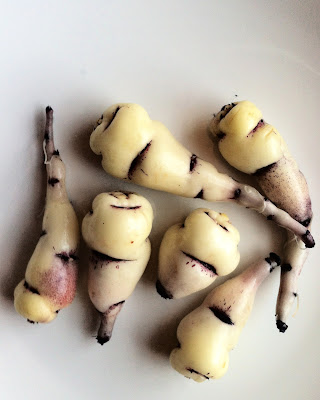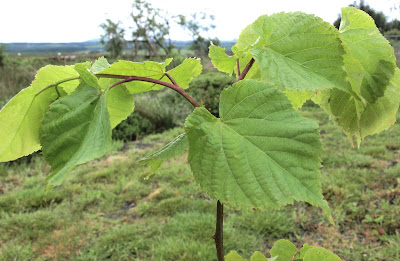According to Caroline Fraser in her book 'Rewilding the World' biodiversity loss is now lining up to be the greatest man-made crisis the world has ever known. It is the Sixth Great Extinction or Holocene extinction event, named after the current geological time period. We now know that the loss of species can actually destroy ecosystems. Caroline says “ … we have learned that everything is interdependent. There are no spare parts … Lose the animals, lose the ecosystems. Lose the ecosystems, game over.”
Ecosystems provide all our basic needs enabling us to survive on this planet. These include the provision of food, water, fuel, fibre and medicine; the regulation of everything within the climate such as air quality, water, disease, pollination and disease; the support of nutrient and water cycling, soil formation and photosynthesis; and cultural benefits such as spiritual and recreational needs.
Rewilding as a conservation strategy is one of the most exciting and promising method of restoring the balance to our ecosystems. An emerging movement, it is based around a new way of looking at conservation. It can be applied to small or large scale projects for the land or the sea.

Trees for Life say that “Nowadays, the definition has come to encompass the whole process of returning ecosystems to a state of ecological health and dynamic balance, making them self-sustaining, without the need for ongoing human management.”
Rewilding ensures natural processes and wild species play a more prominent role. So, after initial support, nature is allowed to take more care of itself.
According to Rewilding Europe “Loss of biodiversity and climate change are among the biggest challenges for mankind. Humans have developed a quasi-geological force and are modifying the planet on a huge scale and at an unprecedented rate. The future of the planet lies in our hands. The time to act is now.”
As part of the solution they envision a European continent where the last wilderness areas are protected and where wildlife, natural processes and biodiversity are allowed to thrive. “Conservation in Europe has been different to the rest of the world. Because most of the wilderness was lost a long time ago, nature conservation focused on cultivated land, ancient farming systems and semi-natural, managed habitats, often depending on public subsidies and private engagement. This compensatory habitat approach has its value and certainly rescued many species from extinction, but an important part for conservation and biodiversity protection was left out; the preservation of wilderness and natural processes.”
Rewilding Britain is a charity who believe that rewilding provides hope for the future for people and nature. “Britain's land is almost all managed. Even in most conservation areas natural processes are arrested. We have lost more of our large mammals than almost any other European country. While the average forest cover in the rest of Europe is 37%, the UK has only 12% … Our national parks are dominated by sheep farms and grouse or deer estates, leaving almost all our hills bare. Over 99% of our seabed is scoured or ploughed by commercial fishing ... Through rewilding we can start to reverse centuries of ecological damage. We can re-establish natural processes, reconnect with nature and regain wonder for the natural world.”
Rewilding Britain want to see at least one million hectares of Britain's land, and 30 per cent of it's territorial waters, supporting natural ecological processes and key species. They say: “The island of Britain is geographically diverse and consists of three nations with differing political systems. Rewilding projects on the ground need to be locally owned and locally run. One thing binds us all – our ecosystems need help.”
 |
| Carrifran - a 1600 acre rewilding project in the Moffat hills |
Ecosystems provide all our basic needs enabling us to survive on this planet. These include the provision of food, water, fuel, fibre and medicine; the regulation of everything within the climate such as air quality, water, disease, pollination and disease; the support of nutrient and water cycling, soil formation and photosynthesis; and cultural benefits such as spiritual and recreational needs.
Rewilding as a conservation strategy is one of the most exciting and promising method of restoring the balance to our ecosystems. An emerging movement, it is based around a new way of looking at conservation. It can be applied to small or large scale projects for the land or the sea.

Trees for Life say that “Nowadays, the definition has come to encompass the whole process of returning ecosystems to a state of ecological health and dynamic balance, making them self-sustaining, without the need for ongoing human management.”
Rewilding ensures natural processes and wild species play a more prominent role. So, after initial support, nature is allowed to take more care of itself.
According to Rewilding Europe “Loss of biodiversity and climate change are among the biggest challenges for mankind. Humans have developed a quasi-geological force and are modifying the planet on a huge scale and at an unprecedented rate. The future of the planet lies in our hands. The time to act is now.”
As part of the solution they envision a European continent where the last wilderness areas are protected and where wildlife, natural processes and biodiversity are allowed to thrive. “Conservation in Europe has been different to the rest of the world. Because most of the wilderness was lost a long time ago, nature conservation focused on cultivated land, ancient farming systems and semi-natural, managed habitats, often depending on public subsidies and private engagement. This compensatory habitat approach has its value and certainly rescued many species from extinction, but an important part for conservation and biodiversity protection was left out; the preservation of wilderness and natural processes.”
Rewilding Britain is a charity who believe that rewilding provides hope for the future for people and nature. “Britain's land is almost all managed. Even in most conservation areas natural processes are arrested. We have lost more of our large mammals than almost any other European country. While the average forest cover in the rest of Europe is 37%, the UK has only 12% … Our national parks are dominated by sheep farms and grouse or deer estates, leaving almost all our hills bare. Over 99% of our seabed is scoured or ploughed by commercial fishing ... Through rewilding we can start to reverse centuries of ecological damage. We can re-establish natural processes, reconnect with nature and regain wonder for the natural world.”
Rewilding Britain want to see at least one million hectares of Britain's land, and 30 per cent of it's territorial waters, supporting natural ecological processes and key species. They say: “The island of Britain is geographically diverse and consists of three nations with differing political systems. Rewilding projects on the ground need to be locally owned and locally run. One thing binds us all – our ecosystems need help.”

















